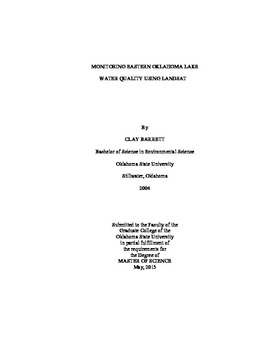| dc.contributor.advisor | Frazier, Amy E. | |
| dc.contributor.author | Barrett, David Clay | |
| dc.date.accessioned | 2016-09-29T18:31:37Z | |
| dc.date.available | 2016-09-29T18:31:37Z | |
| dc.date.issued | 2015-05-01 | |
| dc.identifier.uri | https://hdl.handle.net/11244/45137 | |
| dc.description.abstract | The monitoring of public waters for recreational, industrial, agricultural, and drinking purposes is a difficult task assigned to many state water agencies. The Oklahoma Water Resources Board (OWRB) is only physically monitoring a quarter of the lakes it is charged with monitoring in any given year. The minimal sample scheme adopted by the OWRB is utilized to determine long-term trends and basic impairment but is insufficient to monitor the water quality shifts that occur following influx from rains or to detect algal blooms, which may be highly localized and temporally brief. Recent work in remote sensing calibrates reflectance coefficients between extant water quality data and Landsat imagery reflectance to estimate water quality parameters on a regional basis. Remotely-sensed water quality monitoring benefits include reduced cost, more frequent sampling, inclusion of all lakes visible each satellite pass, and better spatial resolution results. The study area for this research is the Ozark foothills region in eastern Oklahoma including the many lakes impacted by phosphorus flowing in from the Arkansas border region. The result of this research was a moderate r2 regression value for turbidity during winter (0.52) and summer (0.65), which indicates that there is a seasonal bias to turbidity estimation using this methodology and the potential to further develop an estimation equation for this water quality parameter. Refinements that improve this methodology could provide state-wide estimations of turbidity allowing more frequent observation of water quality and allow better response times by the OWRB to developing water impairments. | |
| dc.format | application/pdf | |
| dc.language | en_US | |
| dc.rights | Copyright is held by the author who has granted the Oklahoma State University Library the non-exclusive right to share this material in its institutional repository. Contact Digital Library Services at lib-dls@okstate.edu or 405-744-9161 for the permission policy on the use, reproduction or distribution of this material. | |
| dc.title | Monitoring Eastern Oklahoma Lake Water Quality Using Landsat | |
| dc.type | text | |
| dc.contributor.committeeMember | Comer, Jonathan C. | |
| dc.contributor.committeeMember | Zou, Chris | |
| osu.filename | Barrett_okstate_0664M_13928.pdf | |
| osu.accesstype | Open Access | |
| dc.description.department | Geography | |
| dc.type.genre | Thesis | |
